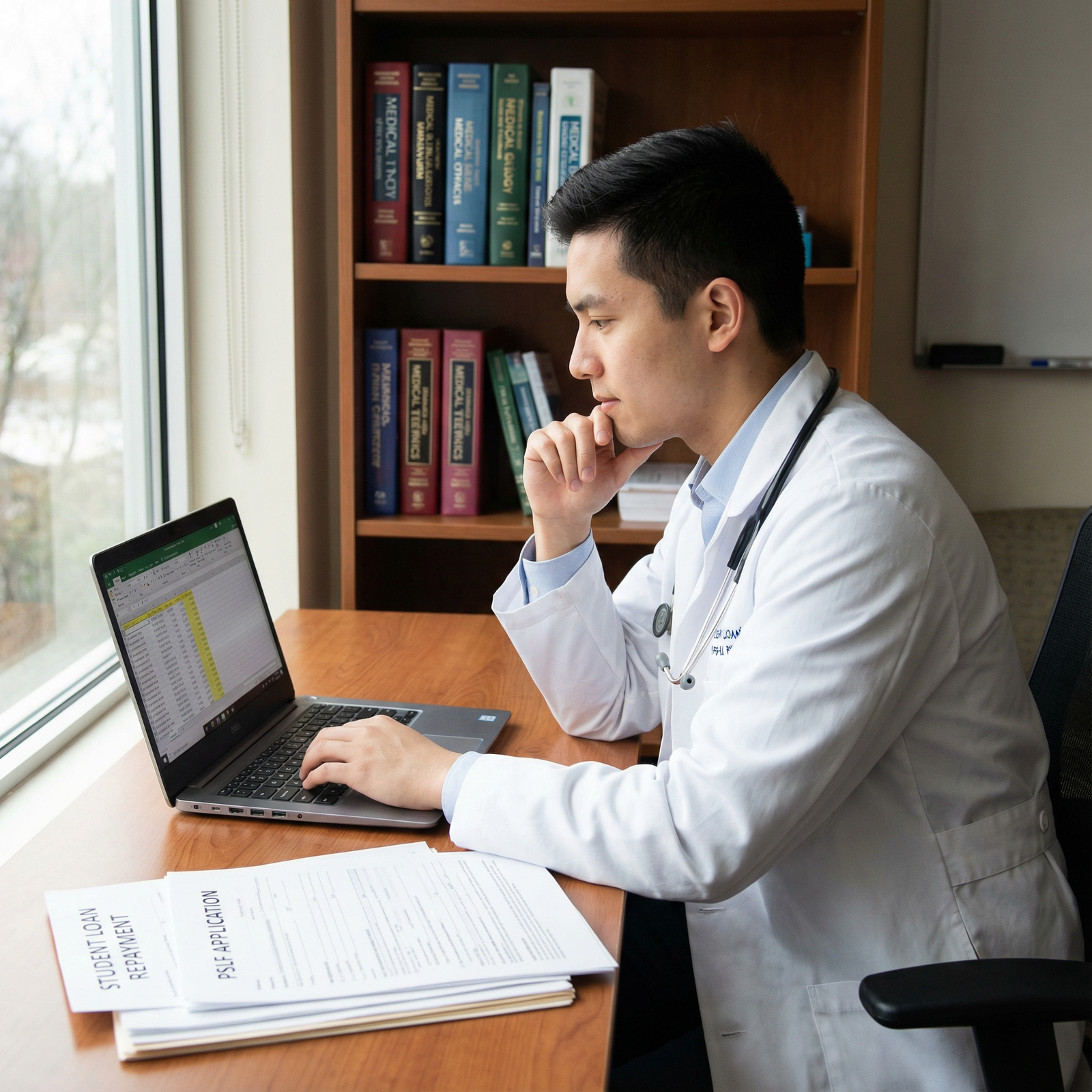Mastering Medical School Debt: Top Repayment Strategies for Students

Entering medical school is a major milestone, but the path from white coat ceremony to attending physician often comes with a six-figure price tag. For many future doctors, student loans feel like a second full-time job—complex, intimidating, and always in the back of your mind.
Yet with the right information and a structured plan, you can move from “overwhelmed by debt” to “in control of your financial future.” This guide walks through effective repayment strategies tailored specifically to medical students and residents, helping you manage medical school loans while still focusing on training and patient care.
Understanding the Scope of Medical School Debt
Before you can design an effective repayment strategy, you need a clear picture of the debt landscape you’re stepping into.
The Real Numbers Behind Medical Education Loans
According to the Association of American Medical Colleges (AAMC), recent U.S. medical school graduates commonly report:
- Median medical school debt: Over $200,000
- Total educational debt (including undergraduate): Frequently $250,000–$300,000+
- Many graduates carry 10–15 separate federal student loans, often from different years and interest rates.
This level of medical school debt affects:
- Where you can afford to live during residency
- How aggressively you can save or invest early in your career
- Your flexibility in specialty choice and practice setting
- Your mental health and burnout risk
Financial literacy and early planning are not luxuries—they are core professional skills for the modern physician.
Types of Student Loans Common in Medical School
Understanding exactly what type of student loans you hold is the foundation of any repayment strategy. Most physicians graduate with a mix of the following:
1. Federal Student Loans
These are issued by the U.S. Department of Education and typically offer the most flexible repayment strategies and loan forgiveness options.
Common federal loans for medical students:
Direct Unsubsidized Loans
- Fixed interest rate (set annually for new loans)
- Interest accrues while in school, during grace, and in residency
- Annual borrowing limits (often require PLUS loans as supplemental funding)
Direct PLUS Loans (Grad PLUS)
- Often higher interest rates than Direct Unsubsidized
- Can cover up to the full cost of attendance minus other aid
- Credit check required, but more lenient than private lenders
Key advantages of federal loans:
- Access to income-driven repayment (IDR) plans
- Eligibility for Public Service Loan Forgiveness (PSLF) and other forgiveness programs
- Built-in protections: deferment, forbearance, and certain discharge options
2. Private Student Loans
Private loans are offered by banks, credit unions, and online lenders. Terms vary widely by lender and borrower profile.
Typical features:
- Fixed or variable interest rates (often tied to credit score)
- No access to federal IDR or federal forgiveness programs
- Limited hardship protections
Private loans can sometimes offer lower interest rates to highly qualified borrowers, but they generally have less flexibility and fewer safety nets—critical considerations for long residency and fellowship training.
3. Institutional or School-Based Loans
Some medical schools offer their own loans or participate in special institutional loan programs.
These may:
- Have subsidized or lower-than-market interest rates
- Offer school-specific repayment arrangements
- Be serviced separately from federal and private loans
Because institutional loan terms vary significantly, you must review each one individually to decide where it fits in your repayment hierarchy.
Building a Solid Financial Foundation During Training
A strong repayment plan starts long before your first attending paycheck. The habits and decisions you make as a student and resident can either magnify or mitigate your future debt burden.
Creating a Realistic, Residency-Friendly Budget
As your income rises from $0 to a resident salary, your expenses often expand just as quickly. Intentional budgeting helps you avoid lifestyle creep and preserves flexibility for long-term goals.
Key steps:
Know Your Net Income
- Look at your resident contract and estimate take-home pay after taxes, retirement contributions, and health insurance.
- Don’t budget using gross income—you’ll overestimate what you can afford.
Categorize Fixed vs. Variable Expenses
- Fixed: Rent, utilities, insurance, minimum loan payments, phone, basic internet
- Variable: Groceries, eating out, transportation, clothing, subscriptions, travel
Prioritize Needs vs. Wants
- Needs: Modest housing near your program, reliable transportation, basic food and utilities
- Wants: High-end apartments, frequent dining out, luxury travel, new car leases
- Small, repeated “wants” during training can quietly add thousands to your effective student loan burden.
Use Tools That Work for Your Schedule
- Budgeting apps (e.g., YNAB, Mint, EveryDollar)
- Simple spreadsheet with monthly review
- Bank account “buckets” (separate accounts or sub-accounts for rent, savings, loan overpayments)
Building an Emergency Fund (Even in Residency)
Emergencies (car repairs, health issues, sudden moves) are a when, not an if. Having even a modest emergency fund can:
- Prevent additional credit card debt
- Allow you to avoid unnecessary forbearance on your loans
- Reduce anxiety during already stressful training years
Target:
- Starter goal: $1,000–$2,000 during medical school
- Intermediate goal: 1–3 months of essential expenses during residency
This may sound ambitious on a resident salary, but even $50–$100 per month builds a meaningful cushion over a few years.

Choosing the Right Federal Repayment Strategy
For most physicians with federal loans, selecting the optimal repayment strategy during residency is a high-yield decision with long-term impact.
Overview of Federal Repayment Options
Key categories:
Standard Repayment Plan
- Fixed monthly payments over 10 years
- Often unaffordable during residency given high loan balances
- Least interest paid over time if you can afford it
Graduated and Extended Plans
- Payments start low and increase over time (graduated), or extend over 25 years (extended)
- Not ideal for those pursuing PSLF because they may not be qualifying IDR plans
Income-Driven Repayment (IDR) Plans
- Base monthly payments on income and family size, not loan balance
- Crucial for most residents and fellows
- Typically required for Public Service Loan Forgiveness
Common IDR plans you may encounter (note: program names and details can evolve, so always verify on studentaid.gov):
PAYE (Pay As You Earn)
- Payments: ~10% of discretionary income
- Forgiveness after 20 years of qualifying payments
- Strong interest subsidy features compared with older plans
- Borrower eligibility restrictions based on “new borrower” definitions
IBR (Income-Based Repayment)
- Payments: 10–15% of discretionary income depending on when loans originated
- Forgiveness after 20–25 years
- Often a fallback for borrowers who do not qualify for PAYE
Other Newer IDR Plans
- As regulations evolve, new IDR options may appear (e.g., recently introduced or updated models with improved interest subsidies or lower payment caps).
- Always review current options before making long-term decisions.
Why IDR Plans Are Built for Residency
During residency and fellowship, your income is relatively low while your loan balance is very high. Under these conditions:
- A standard 10-year payment could easily exceed $2,000–$3,000 per month.
- An IDR payment may be closer to $200–$500 per month, depending on location, taxes, and household size.
Benefits of IDR during training:
- Keeps cash flow manageable while still making progress
- Monthly payments count toward:
- Long-term IDR forgiveness (20–25 years), and
- PSLF (if you work for a qualifying employer)
- Provides flexibility if you pursue additional training or fellowships
Strategic Considerations for IDR Selection
When evaluating IDR options:
Goal: PSLF vs. Payoff
- If you are strongly leaning toward an academic hospital or nonprofit system, PSLF may be optimal.
- If you expect to work in private practice or a high-paying specialty and don’t plan on PSLF, your goal may be to minimize total interest paid and pay off loans faster after training.
Spousal Income
- Married borrowers should consider whether plans allow married filing separately to reduce payment calculations, and how that affects overall tax liability.
Interest Accrual and Subsidies
- Some IDR programs provide partial interest subsidies, especially where payments don’t cover full monthly interest. This can significantly impact total cost over residency and fellowship.
Consulting with a student loan–savvy financial advisor or your school’s financial aid office can help you compare projected costs across multiple scenarios.
Leveraging Loan Forgiveness and Repayment Assistance Programs
The federal government and many states recognize the debt burden faced by physicians and offer structured repayment strategies to attract doctors to high-need areas or public service.
Public Service Loan Forgiveness (PSLF)
PSLF can be extraordinarily powerful for physicians with large federal student loans who plan to stay in the nonprofit or government sector.
To qualify for PSLF, you must:
- Have Direct federal loans
- Work full-time for a qualified employer:
- 501(c)(3) nonprofit hospitals
- Government-owned hospitals and clinics
- Many academic medical centers
- Make 120 qualifying monthly payments:
- Under a qualifying IDR plan
- While employed full-time at a qualifying employer
- Submit PSLF forms regularly:
- Complete and submit the PSLF form annually or whenever you change employers
For many physicians, the timeline looks like:
- 3–7 years: Residency and fellowship at a qualifying nonprofit hospital
- 3–7 years+: Attending role at a nonprofit academic or hospital-based practice
After 10 cumulative years (120 payments), any remaining federal Direct loan balance may be forgiven tax-free under current law.
National Health Service Corps (NHSC)
The NHSC Loan Repayment Program offers significant loan repayment (not just forgiveness at the end) in exchange for service in Health Professional Shortage Areas (HPSAs).
Typical features:
- Two-year service commitments in approved sites (often primary care, psychiatry, OB/GYN, etc.)
- Structured awards (e.g., tens of thousands of dollars) toward your qualifying student loans
- Opportunities to extend service and receive additional repayment
This can be combined strategically with IDR and potentially PSLF if the site is a qualifying nonprofit employer.
State and Specialty-Specific Loan Repayment Programs
Many states offer their own programs to attract physicians to underserved rural or urban communities.
Examples include:
- State-sponsored rural physician loan repayment programs
- Mental health professional repayment incentives
- Veterans Affairs (VA) and military scholarship/repayment programs
Action steps:
- Check your state’s health department or Area Health Education Center (AHEC) website
- Ask your residency program leadership about state or institutional loan repayment benefits
- Consider whether these programs align with your long-term practice and lifestyle goals
Refinancing and Consolidation: When (and When Not) to Use Them
Two commonly confused tools—consolidation and refinancing—play very different roles in student loan management.
Federal Direct Consolidation
What it does:
- Combines multiple federal loans into one new Direct Consolidation Loan
- Results in a weighted-average interest rate (rounded up slightly)
Potential benefits:
- Simplifies management with a single servicer and payment
- May be required to convert older FFEL or Perkins loans into Direct loans eligible for PSLF and modern IDR plans
Potential drawbacks:
- Can reset certain repayment clocks if done incorrectly (e.g., PSLF)
- May extend repayment, leading to more total interest if payments are not increased later
For PSLF-bound physicians:
- If you already have only Direct loans, consolidation is usually optional.
- If you have older FFEL or Perkins loans, consolidation into the Direct program is often necessary for PSLF—but timing matters. Seek advice before consolidating mid-residency.
Private Refinancing
What it does:
- You take out a new private loan to pay off existing federal and/or private loans
- New interest rate and term based on your credit and income
When refinancing might make sense:
- You are an attending with stable, high income and:
- Do not plan to use PSLF or federal forgiveness
- Have strong credit and can qualify for a significantly lower interest rate
- Want a clear, aggressive payoff timeline
Major cautions:
- Refinancing permanently removes federal protections:
- No federal IDR plans
- No PSLF eligibility
- Limited deferment/forbearance compared to federal options
- Residents should be very cautious about refinancing federal loans, as you cannot “undo” this decision later if your plans change.
Some lenders offer resident-specific refinancing with lower payments during training, but the loss of federal benefits remains a critical consideration.
Accelerated Repayment and Smart Overpayments
Once your financial situation improves—often late residency or early attending years—you may choose to accelerate repayment.
Prioritizing Which Loans to Attack First
Common approach: the debt avalanche method—focus extra payments on the highest interest rate loans first while maintaining minimum payments on others.
Typical priority sequence for many physicians:
- Highest interest private loans
- High-interest Grad PLUS loans
- Other federal loans (while considering forgiveness potential)
- Any remaining lower-rate institutional or subsidized loans
If you are pursuing PSLF:
- Overpaying federal loans that will be forgiven anyway may not be optimal.
- Instead, consider directing “extra” money into:
- Retirement accounts (401(k), 403(b), 457(b), Roth IRA)
- Emergency fund and insurance protections
- Savings for major goals (home, family, relocation)
How to Make Sure Extra Payments Count
To ensure your overpayments reduce principal:
- Log into your loan servicer and:
- Select “apply extra amount to current principal” or
- Designate extra funds to the specific loan with the highest interest
- Confirm that the servicer does not simply “advance due dates” without reducing principal as intended
Enhancing Financial Literacy as a Core Clinical Skill
Financial literacy for physicians is no longer optional; it directly affects burnout, career satisfaction, and even professional autonomy.
Use Available Resources Early and Often
Most medical schools, residency programs, or professional societies offer:
- Workshops on student loans, budgeting, and retirement basics
- Access to financial wellness counselors or outside experts
- Online modules and calculators to model different repayment strategies
High-yield topics for trainees include:
- Understanding compound interest and amortization
- Basics of insurance (disability, life, malpractice)
- Retirement accounts and employer matches
- Tax planning, especially with IDR and married status
Protecting Your Future Self
As you develop a debt repayment timeline, integrate:
Short-term goals (0–5 years):
- Complete residency with systems in place
- Maintain mental and physical health
- Avoid additional high-interest debt
- Build a starter emergency fund
Intermediate goals (5–10 years):
- Finalize specialty training
- Decide between PSLF vs. full payoff
- Obtain adequate disability and life insurance
- Begin serious retirement contributions
Long-term goals (10+ years):
- Achieve financial independence or flexibility
- Plan for kids’ education, practice ownership, or academic careers
- Align money decisions with life and career values
Leveraging Side Income Strategically
When used thoughtfully and in moderation, side gigs during medical school or residency can:
- Accelerate student loan repayment
- Provide resume-boosting experience
- Expand your professional network
Common Side Gigs for Medical Trainees
Telemedicine (for licensed residents/fellows)
Careful coordination with program policies and duty hour regulations is essential. Can be particularly accessible in non-procedural specialties.Medical Writing and Editing
- Creating content for health websites
- Reviewing CME materials
- Contributing to exam prep resources
Tutoring and Teaching
- MCAT, USMLE, or shelf exam tutoring
- Small group teaching for undergrads or pre-meds
Research and Grant-Funded Roles
- Paid research assistant roles in academic departments
- Quality improvement or data analysis projects
Balance is critical: no side gig should jeopardize your performance, wellness, or duty hour compliance. Think of side income as a tool to support your larger financial plan, not a requirement.
Real-World Application: A Med School Debt Success Story
Consider the fictional example of Dr. Emily Chen, who graduated with $250,000 in combined undergraduate and medical school loans:
During Residency
- Enrolled in an IDR plan with payments aligned to resident income
- Worked at a nonprofit academic medical center, making all eligible payments count toward PSLF
- Built a small emergency fund and avoided high-cost lifestyle upgrades
Career Choice
- Pursued a primary care career in an underserved region at a nonprofit clinic
- Qualified for both state-based loan repayment assistance and continued PSLF-qualifying employment
Side Income
- Took on limited telemedicine shifts and medical writing work
- Used side income for targeted extra payments on her small private loan and to build savings
Over ten years, Emily:
- Kept federal loan payments manageable during training
- Received loan forgiveness on the remaining Direct loan balance through PSLF
- Eliminated her small private loans using side income and modest lifestyle choices
The key was not perfection, but intentionality—small, consistent decisions aligned with a clear long-term plan.

Frequently Asked Questions (FAQ)
1. When should I start thinking about student loan repayment strategies?
Start as early as possible—ideally before or during medical school, not after graduation. At minimum, before residency begins you should:
- Inventory all your loans (types, balances, interest rates)
- Decide on a provisional IDR plan for PGY-1
- Understand whether PSLF or other forgiveness programs fit your likely career path
Waiting until payments are due can limit your options and increase stress.
2. Can I qualify for loan forgiveness while in residency?
Yes. Many residents working at nonprofit or government hospitals are already employed by PSLF-qualifying institutions. If you:
- Have Direct federal loans
- Enroll in a qualifying IDR plan
- Work full-time at an eligible employer
Then your residency (and fellowship) years can count toward the 120 PSLF payments required for forgiveness. This is a major reason to set up your repayment plan correctly before PGY-1 or early in training.
3. Should I refinance my student loans as a resident?
Often, no—at least not your federal loans. Refinancing federal loans into private loans as a resident usually means:
- Losing eligibility for PSLF
- Losing access to IDR plans
- Giving up flexible federal protections
Exceptions may include residents with:
- Significant high-interest private loans
- No intention of working in public or nonprofit sectors
- A clear plan and risk tolerance for earlier, aggressive payoff
Even then, cautious review and professional advice are strongly recommended.
4. How do income-driven repayment plans calculate my payment?
IDR plans generally base payments on a percentage of your discretionary income, defined as:
Adjusted Gross Income (AGI) – (a multiple of the federal poverty guideline for your household size and state)
Key factors:
- Your tax filing status (single vs. married; joint vs. separate)
- Your family size
- Your most recent tax return or alternative documentation of income
If your income changes significantly (e.g., finishing residency), you can recertify earlier or at the required annual recertification.
5. What are some realistic ways to supplement my income during medical school or residency?
Common, manageable options include:
- Part-time medical writing or editing
- Tutoring for pre-med or medical exams
- Paid research or quality improvement roles
- Limited telemedicine shifts during residency (where permitted)
- Non-clinical freelance work that fits your schedule and does not violate program policies
Always ensure any side work:
- Complies with your program’s rules and duty hour limits
- Does not compromise clinical performance or rest
- Aligns with your long-term professional reputation
By approaching your student loans with the same strategic thinking you bring to clinical decision-making, you can transform overwhelming medical school debt into a manageable, structured part of your path from student to attending. With clear goals, informed choices, and consistent follow-through, your financial health can support—not hinder—your growth as a physician.

SmartPick - Residency Selection Made Smarter
Take the guesswork out of residency applications with data-driven precision.
Finding the right residency programs is challenging, but SmartPick makes it effortless. Our AI-driven algorithm analyzes your profile, scores, and preferences to curate the best programs for you. No more wasted applications—get a personalized, optimized list that maximizes your chances of matching. Make every choice count with SmartPick!
* 100% free to try. No credit card or account creation required.













